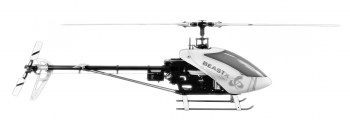Translations:Manuals:MBUltraFblV5:Setupmenu K/2/en: Difference between revisions
Importing a new version from external source |
Importing a new version from external source |
||
| Line 6: | Line 6: | ||
|}<br /> | |}<br /> | ||
<br /> | <br /> | ||
Initially you should see 0 degrees of pitch now (in case you did the | Initially you should see 0 degrees of pitch now (in case you did '''setup the trimming''' at SETUP MENU point '''J''' properly!). Then you switch to the adjustment position. The system will give some amount of pitch which you measure again. This time you should see 6.0 degrees (+ or - is not of importance). If not, increase or decrease the swash throw accordingly.<br /> | ||
<br /> | <br /> | ||
The color of the Status LED gives some indication whether you rotorhead geometry is well suited for flybarless usage or not. Ideally the Status LED on the device should be blue when in 6.0 degress position. If it isn't, this means your servo movements cause very much pitch deflection on the rotorhead. This can be bad for the performance as the system may tend to oversteer and overreact very easily. If you have problem with finding correct gain settings or overcompensation later in flight, the cause may be found here. To solve this you can change geometry by moving the linkage balls on the servo horns closer to the servo center.<br /> | The color of the Status LED gives some indication whether you rotorhead geometry is well suited for flybarless usage or not. Ideally the Status LED on the device should be blue when in 6.0 degress position. If it isn't, this means your servo movements cause very much pitch deflection on the rotorhead. This can be bad for the performance as the system may tend to oversteer and overreact very easily. If you have problem with finding correct gain settings or overcompensation later in flight, the cause may be found here. To solve this you can change geometry by moving the linkage balls on the servo horns closer to the servo center.<br /> | ||
Latest revision as of 07:55, 1 March 2023
At SETUP MENU point K we adjust the internal servo throw so that MICROBEAST ULTRA has a reference on how far it must move the servos when controlling the helicopter. To set the throw, you align one rotorblade on the longitudinal axis (in parallel to the tail boom) and measure the cyclic pitch with a digital pitch gauge on this rotorblade. (You can do this from the front or from the rear!)

|

|
Initially you should see 0 degrees of pitch now (in case you did setup the trimming at SETUP MENU point J properly!). Then you switch to the adjustment position. The system will give some amount of pitch which you measure again. This time you should see 6.0 degrees (+ or - is not of importance). If not, increase or decrease the swash throw accordingly.
The color of the Status LED gives some indication whether you rotorhead geometry is well suited for flybarless usage or not. Ideally the Status LED on the device should be blue when in 6.0 degress position. If it isn't, this means your servo movements cause very much pitch deflection on the rotorhead. This can be bad for the performance as the system may tend to oversteer and overreact very easily. If you have problem with finding correct gain settings or overcompensation later in flight, the cause may be found here. To solve this you can change geometry by moving the linkage balls on the servo horns closer to the servo center.
| Status-LED | Cyclic throw |
| purple | not good |
| red | OK |
| blue | perfect! |